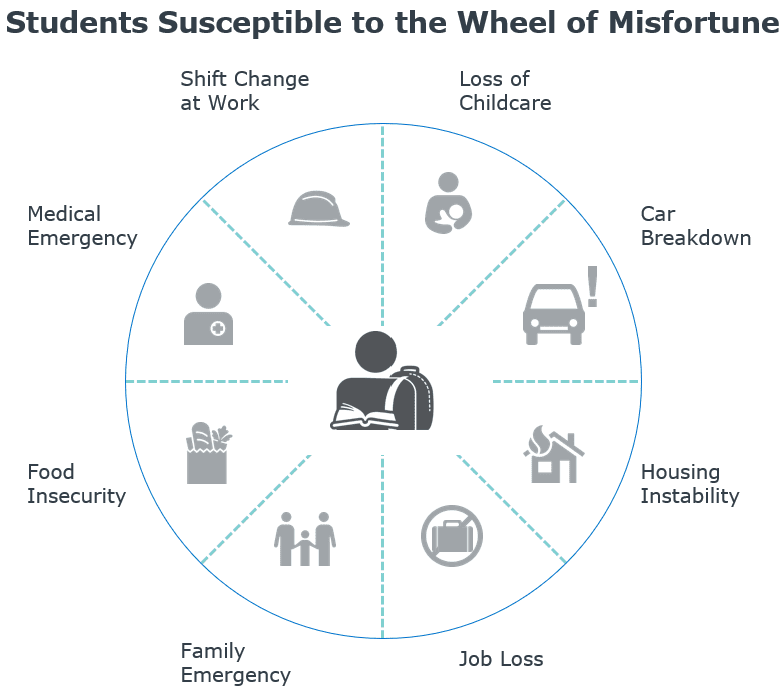High school graduates are going to work instead of college. Can we prove they don’t have to choose?
More and more high school graduates are opting out of higher education in part because of a hot labor market. How do we show they don’t have to choose between their college aspirations and surging wages? Strategies we’ve been using for adult learners for years might hold the answer.
I have spent most of my higher education career serving post-traditional learners-first military students, then new immigrants to the US, and now as an adjunct faculty member at a community college. My experience with these students has demonstrated that their ability to succeed is as much dictated by the circumstances they find on campus as those that make up their lives.
Post-traditional learners are post-secondary students who must balance competing life, work, and academic priorities. They may be over the age of 25, care for dependents, work full-time, or be affiliated with the military.
This insight led me to consider how we can apply successful adult learner strategies to meet the needs of recent high school graduates who are drawn to the workforce. The best way to engage these prospective students is to ensure they can balance work and college. Whether they enroll soon after high school or years later when higher education represents a path to professional growth and better wages, we need to demonstrate that our institutions understand that students have competing personal, professional, and academic priorities
In this blog, I’ll share three lessons learned from institutions that support post-traditional learners that you can apply to meet the needs of today’s students.
1. Prepare for interruptions
When I ask cabinet leaders why students leave college, I’m frequently told, “Life got in the way.” Students would say the same thing. Life does not happen on a schedule. But when students who miss class are penalized or have no way to catch up on the material they missed, institutions send the message that they won’t tolerate unavoidable interruptions.
We must accommodate life’s disruptions to serve today’s students. Lakeshore Technical College leads the way in providing flexibility for its students. The College’s iFlex offerings allow students to easily transition between face-to-face and online course delivery within the same course. So, if they have to cover an extra shift at work or their car breaks down, students can stay on pace with the rest of their class.
2. Provide curricular flexibility
Today’s college students need flexibility. A single event can derail their best efforts in the classroom. These obstacles can have a far greater effect when students are enrolled in 15-week terms. Medical issues, a canceled baby-sitter, or a shift change at work can put enormous pressure on students trying to keep up in four or five concurrent classes.
In addition to providing more flexibility, accelerated courses are linked to better student success outcomes. When Trident Technical College moved the majority of its courses to 7-week terms, it saw students’ course pass rates improve by 13 percentage points. Shorter-term lengths mean students are preparing for half as many mid-terms or final projects as they would if they took classes in a standard term.
Campbell University meets this demand with accelerated courses offered both online and in their community. This allows students to choose the course format that makes the most sense for them. They can combine online and face-to-face options to create the right balance for their lives.

3. Use student employment as a retention strategy
Many younger students already need to balance work and academics. More than 70% of part-time and nearly 40% of full-time students under the age of 24 work while enrolled in college. Many of these jobs are in retail or hospitality-fields that may be unrelated to students’ career goals. Yet, many college leaders overlook the role they can play meeting students’ need to work while balancing academic expectations. Campus-based jobs can help students build work experience related to their discipline and prepare them to work in professional environments.
The University of the District of Columbia (UDC) hires current students as part-time staff to serve as peer advisors. They work up to 20 hours per week as frontline student support. UDC has reported that this model works because it increases staff capacity and students are more likely to seek help when they need it, which has strengthened the University’s efforts to connect students with timely information. For example, peer advisors discovered they were repeatedly getting asked the same questions. They made the information more accessible by creating videos to teach their peers how to pay or register for classes.
This kind of program benefits everyone involved. It helps the peer advisors by offering paid work that aligns well with their academic success. They, in turn, provide a virtually indispensable service to fellow students.
Traditional higher ed institutions can learn from the flexibility and career readiness that is used in schools that serve more post-traditional learners. We are seeing the lowest unemployment rates in over a half-century. We must show college students that they can enroll and earn competitive wages to offset the cost of pursuing their academic goals.
Ready to find out more?
Visit the Enrollment Growth Strategy Resource Center to learn more about the growing non-consumer market and how to engage prospective undergraduate students.
More Blogs

Is your yield rate okay?

EAB Wrapped 2025: A year of reckoning—and reinvention—in higher ed
